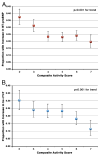Physical activity, change in biomarkers of myocardial stress and injury, and subsequent heart failure risk in older adults
- PMID: 23158528
- PMCID: PMC3591516
- DOI: 10.1016/j.jacc.2012.08.1006
Physical activity, change in biomarkers of myocardial stress and injury, and subsequent heart failure risk in older adults
Abstract
Objectives: The aim of this study was to evaluate the association between physical activity and changes in levels of highly sensitive troponin T (cTnT) and N-terminal pro-B-type natriuretic peptide (NT-proBNP), and the subsequent risk of the development of heart failure (HF) in community-dwelling older adults.
Background: Higher baseline levels of cTnT and NT-proBNP and increases over time correlate with the risk of HF in older adults. Factors modifying these levels have not been identified.
Methods: NT-proBNP and cTnT were measured at baseline and 2 to 3 years later in adults 65 years of age and older free of HF participating in the Cardiovascular Health Study. Self-reported physical activity and walking pace were combined into a composite score. An increase was prespecified for NT-proBNP as a >25% increment from baseline to ≥190 pg/ml and for cTnT as a >50% increment from baseline in participants with detectable levels (≥3 pg/ml).
Results: A total of 2,933 participants free of HF had NT-proBNP and cTnT measured at both time points. The probability of an increase in biomarker concentrations between baseline and follow-up visits was inversely related to the physical activity score. Compared with participants with the lowest score, those with the highest score had an odds ratio of 0.50 (95% confidence interval: 0.33 to 0.77) for an increase in NT-proBNP and an odds ratio of 0.30 (95% confidence interval: 0.16 to 0.55) for an increase in cTnT, after adjusting for comorbidities and baseline levels. A higher activity score associated with a lower long-term incidence of HF. Moreover, at each level of activity, an increase in either biomarker still identified those at higher risk.
Conclusions: These findings suggest that moderate physical activity has protective effects on early heart failure phenotypes, preventing cardiac injury and neurohormonal activation.
Copyright © 2012 American College of Cardiology Foundation. Published by Elsevier Inc. All rights reserved.
Figures



Comment in
-
Can we prevent heart failure with exercise?J Am Coll Cardiol. 2012 Dec 18;60(24):2548-9. doi: 10.1016/j.jacc.2012.09.021. Epub 2012 Nov 14. J Am Coll Cardiol. 2012. PMID: 23158537 No abstract available.
References
-
- Erikssen G, Liestol K, Bjornholt J, Thaulow E, Sandvik L, Erikssen J. Changes in physical fitness and changes in mortality. Lancet. 1998;352:759–62. - PubMed
MeSH terms
Substances
Grants and funding
- R56 AG020098/AG/NIA NIH HHS/United States
- N01 HC055222/HL/NHLBI NIH HHS/United States
- N01 HC085079/HL/NHLBI NIH HHS/United States
- R01 HL080295/HL/NHLBI NIH HHS/United States
- R01 AG020098/AG/NIA NIH HHS/United States
- R01 AG015928/AG/NIA NIH HHS/United States
- U01 HL080295/HL/NHLBI NIH HHS/United States
- N01 HC015103/HC/NHLBI NIH HHS/United States
- N01 HC085086/HL/NHLBI NIH HHS/United States
- N01 HC075150/HL/NHLBI NIH HHS/United States
- R01 AG023629/AG/NIA NIH HHS/United States
- R01 AG027058/AG/NIA NIH HHS/United States
- N01 HC045133/HC/NHLBI NIH HHS/United States
- N01 HC035129/HC/NHLBI NIH HHS/United States
- R56 AG023629/AG/NIA NIH HHS/United States
LinkOut - more resources
Full Text Sources
Other Literature Sources
Medical
Research Materials
Miscellaneous

